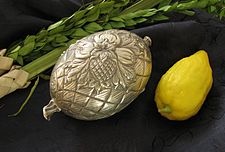
This week’s d’var Torah is sponsored by Gershon and Leah Vandenbrink with best wishes for a joyous Sukkot.
In rabbinic literature, Sukkot is known simply as “Chag,” (the holiday), implying that it is the holiday par excellence. It is the most joyous of holidays both thematically and experientially. It is our z’man simchateinu, the time of our happiness.
In Temple times it was marked by the simchat beit hashoeva, which one might describe as “all night parties featuring a sound and light show”, with music, juggling, fire, food and even a parade, activities which are replicated today in one form or another. The festivities were such that the Talmud declares that “whomever did not see the simchat beit hashoeva has never seen joy in his days” (Sukkah 51a).
The extra joy of Sukkot is no doubt related to the fact that this chag celebrates the merging of two sets of holidays into one. It marks the end of the High Holiday period of personal introspection and reflection. Rosh Hashanah and Yom Kippur focus on the seriousness and awesomeness of our encounter with G-d. With the books of life and death open before G-d, we are unable to sing the songs of Hallel, songs of praise to the Almighty. It may be Yom Tov, but we fast—some early authorities ruled that it is most appropriate to fast during the days of Rosh Hashanah—and we might even cry as the dread of having failed in our Divine mission stares us in the face.
Yet this encounter with G-d can and must lead to great joy. It is meant to reassure us that—despite appearances to the contrary, and despite our inability to fathom His ways—G-d, the Master of the Universe, is just and compassionate. This is most comforting and reassuring. To truly and fully believe in G-d is a most difficult mitzvah; but the greater our faith, the greater joy we will be able to attain.
On Sukkot we are confident that whatever may transpire, we are protected by the sheltering wings of G-d. By leaving our homes and entering the Sukkah, we assert that neither our homes nor our wealth can ultimately protect us. We may dwell in a flimsy hut lacking a roof, but G-d is above us. Sukkot, just five days after Yom Kippur, is truly a time of great joy. With our spiritual batteries recharged, we are able to feel the presence and protection that G-d offers.
But this is only one side of Sukkot. Sukkot is also the last of the shalosh regalim, the three pilgrim festivals of Pesach, Shavuot and Sukkot. These times of joy commemorate great historical events in the formation of our people, and also celebrate the blessings of the land of Israel.
The Exodus from Egypt was the necessary first step to enable us to ultimately form a great nation in Israel . We were given the Torah on Shavuot, much of which can only be—and all of which is meant to be—implemented specifically in the land of Israel. Our ancestors dwelled in huts in the desert as they journeyed to our permanent home in Israel.
History and agriculture, the people and the land, join together in joy three times a year. Personal introspection is superseded by national joy, as a united people gather together to celebrate in Jerusalem. Rosh Hashanah and Yom Kippur, focusing on the individual, require no pilgrimage to our national capital.
This duality of Sukkot is reflected in the special Mussaf offerings that are brought on all festivals. On Pesach and Shavuot, and on Rosh Hashanah and Yom Kippur, the Jewish people were to offer one ram and seven lambs (and either one or two bulls) as an elevation offering. Yet on Sukkot, these numbers are doubled so that we must bring two rams and 14 lambs. With two holiday motifs, two sets of sacrifices are required. Interestingly, instead of just doubling the number of bulls, we bring a total of 70 bulls over the course of the holiday. The bull symbol of strength and power is most prominent on this most joyous of holidays.
It is not by chance that our rabbis appended the (relatively recent) holiday of Simchat Torah to that of Sukkot. What greater simcha (joy) can there be than the merging of our personal relationship with G-d and our national identity.
Chag Sameach.



